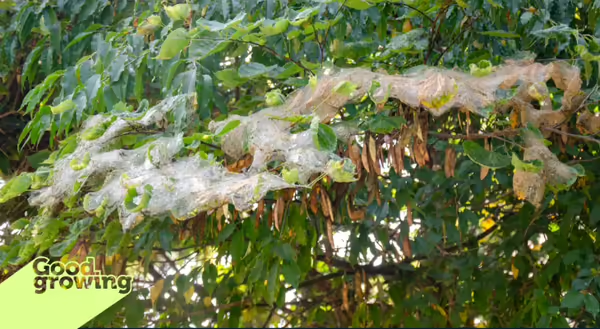
There are many ways we mark the 'end of summer'. Some refer to the beginning of school or the closing of the pool, while others view Labor Day as the 'unofficial end of summer'. Another way, if you're more entomologically inclined, is the appearance of fall webworm.
Fall webworm (Hyphantria cunea) 'nests' often start becoming noticeable in our landscapes during the late summer and early fall. The caterpillars will spin their communal webs on the ends of branches on which they are feeding. They have been found on over 400 different species of trees and shrubs. In Illinois, they are most commonly found on crabapple, walnut, hickory, pecan, redbud, sweetgum, maple, and oak.
What Do Fall Webworms Look Like?
There are two races of caterpillars. The black-headed race has, as the name implies, a black-head. Their bodies are yellowish with a dark stripe on the back, and long white hairs rising from black bumps. The red-headed race has a red head with a yellowish-tan body and brownish hair that arises from reddish-brown bumps (the bumps are called tubercles).
The black-headed caterpillars will eventually turn into bright white moths. The red-headed caterpillars will turn into white moths with dark spots on their wings. While both races can be found throughout their range (much of North America, from southern Canada to Mexico), the black-headed race is more prevalent in the northern part, and the red-headed race in the southern part.
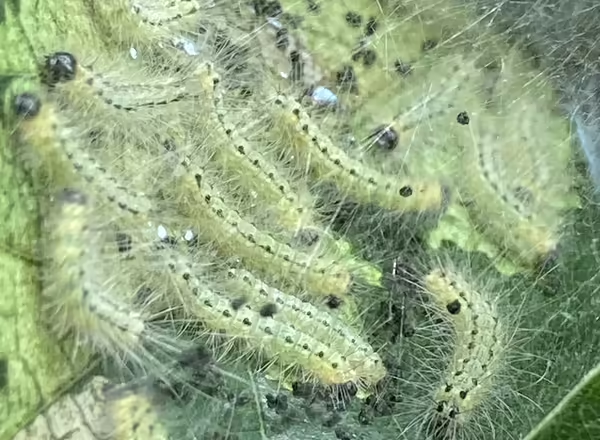
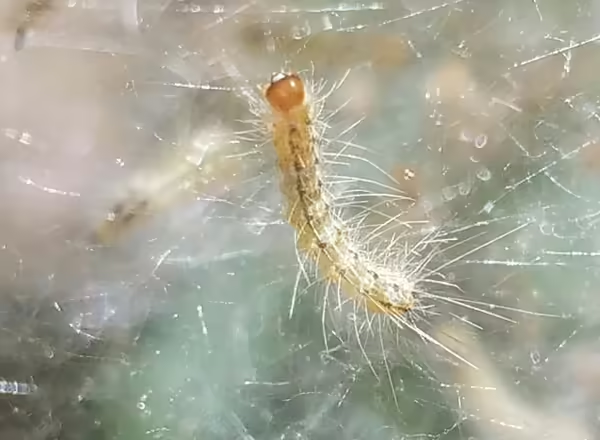
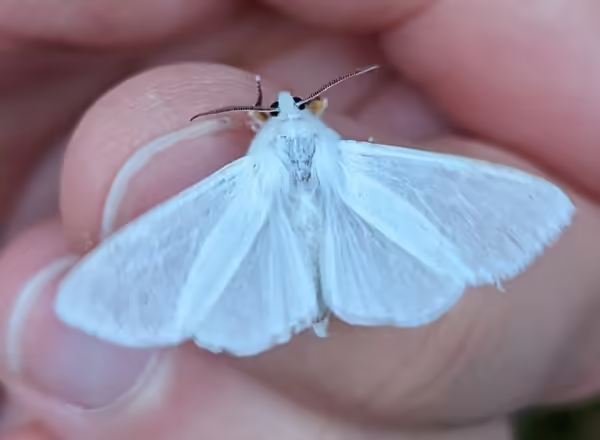
Fall Webworm Life Cycle
Fall webworms will begin to emerge in the summer. The females will lay egg masses that contain several hundred eggs on the undersides of leaves. About seven days later, the larvae (caterpillars) will hatch.
In the southern half of Illinois, fall webworm will have two generations per year, with the first generation typically appearing in June and the second generation in August and September. In the northern half of the state, there is only one generation in August and September.
The caterpillars will spin a silk web over the leaves and will remain inside the webbing as they feed. As they exhaust their food supply, they will continue to enlarge the webbing. After feeding for around 4 to 6 weeks, the caterpillars will leave the webbing and spin a cocoon in leaf litter or bark crevices to pupate.
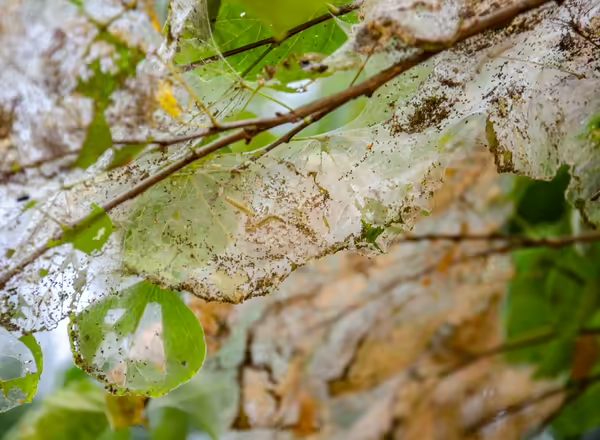

Managing Fall Webworm
The webbing created by fall webworm can act as a beacon, drawing your attention to the damage they cause. In most cases, only a branch here or there will be attacked. Occasionally, though, entire branches, or trees in extreme cases, can be stripped of leaves if populations get high enough. As alarming as it may be, it's unlikely to do any long-term damage to established trees. However, newly planted trees could be at risk of harm if there is enough feeding.
The damage fall webworms cause happens later in the year, and the leaves they feed on have done most of the work they need for the year. They also only feed on the leaves; they leave the buds of next year's leaves alone (the trees should leaf out just fine next year). Add this all up, and management of fall webworm isn't usually warranted.
The primary problem with fall webworm is aesthetics. If you just can't stand the sight of them, or if you have a newly planted tree being attacked, there are several things you can do.
- One common way of managing them is to prune the affected branches out of trees. Keep in mind that the webbing is only temporary; any pruning you do will be permanent and can potentially hurt the aesthetics of the plant.
- Webs can be removed manually, either by hand, using a stick, or some other device, and then destroyed.
- Burning the webs is not recommended. Fire will likely damage the plants far more than the webworms ever will.
- The water-resistant webbing that fall webworms create makes it difficult to control them with pesticides. If pesticides are used, use enough pressure to penetrate the webbing or tear it open before spraying. Keep in mind that any chemical used may have an impact on any predators and parasitoids that may attack the fall webworm.
- You can also let nature take its course. At least 50 species of parasitoids and dozens of predators have been found to attack fall webworm, which is why webworm populations are often cyclical (pest populations build up, natural enemies move in, and pest populations fall).
Instead of worrying about their presence, think of fall webworms as a sign of what's to come: cooler temperatures, changing leaf colors, and pumpkin spice everywhere.
Good Growing Fact of the Week: Fall webworm and eastern tent caterpillar are often confused with one another. Eastern tent caterpillars are out earlier in the year (spring), create webbing in the forks and crotches of trees, and will leave their webs to feed.
Bonus Fact of the Week: In addition to differing in appearance, the different races of fall webworms' nets/webs also differ. The webs of black-headed larvae are thin and flimsy, while the webs of red-headed larvae are larger and denser.
Bonus Fact of the Week #2: While we focus on invasive species that come from other parts of the world to the U.S., we aren't the only place with invasive species. Fall webworm has been accidentally introduced in many parts of Europe and Asia, where it has become a major pest.
Reference and for more information:
Schowalter, T. D., and D. R. Ring. 2017. “Biology and Management of the Fall Webworm, Hyphantria Cunea (Lepidoptera: Erebidae).” Journal of Integrated Pest Management 8 (1). https://doi.org/10.1093/jipm/pmw019.
Photos
Adult moth - Ben Keen, Public Domain, iNaturalist
Caterpillars - black-headed: Allen Hurlbert, Public Domain, iNaturalist; red-headed: Lottery Discountz, Public Domain, iNaturalist
Want to get notified when new Good Growing posts are available? SIGN ME UP!
Give us feedback! How helpful was this information (click one): Very helpful | Somewhat helpful | Not very helpful
MEET THE AUTHOR
Ken Johnson is a Horticulture Educator with University of Illinois Extension, serving Calhoun, Cass, Greene, Morgan, and Scott counties since 2013. Ken provides horticulture programming with an emphasis on fruit and vegetable production, pest management, and beneficial insects. Through his programming, he aims to increase backyard food production and foster a greater appreciation of insects.